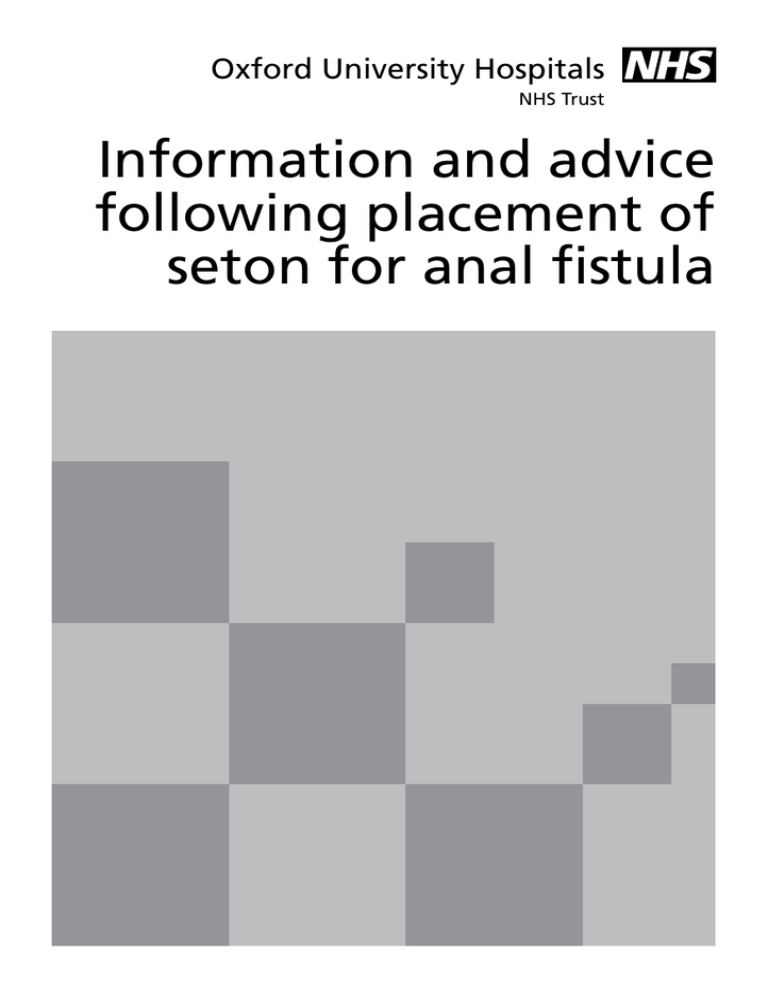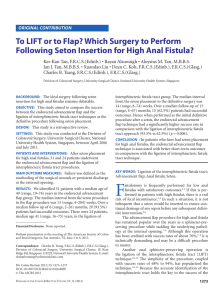Information and advice following placement of seton for anal fistula
advertisement

Oxford University Hospitals NHS Trust Information and advice following placement of seton for anal fistula page 2 What is a fistula? You can get an anal fistula as a result of an infection or a collection of pus (abscess) in or around your anus. It can also be caused by conditions which affect your bowel, such as Crohn’s disease. There are different types of fistula. Some develop as a single tunnel (tract) running from your rectum through to the skin near your anus. Others may be more complex and branch off into more than one opening. Sometimes they cross the muscles which control the opening and closing of your anus (sphincter muscles). This can cause problems with controlling your bowel movements and may cause you to be incontinent. Symptoms and signs of anal fistula can be there all the time or may disappear for a while before coming back. Symptoms of an anal fistula can include: • pus from your anal area • pain and discomfort in and around your anus • bleeding from in and around your anal area • irritation of the skin around your anus • an open hole or wound near to your anus • a collection of pus (an abscess). page 3 What is a seton? A seton is a thin silicone string (very similar to an elastic band) which is inserted into the fistula tract. This allows the fistula to drain and heal from the inside out. This procedure is normally carried out under general anaesthetic. This means you will be asleep throughout the operation. After the seton has been placed in the fistula tract, the wound will be covered with a light, padded dressing. As long as there are no complications, you should be able to go home later in the day. Fistula surgery is often “staged”. This means that it may be done over a series of operations. If necessary, further operations may be carried out to adjust or replace the seton. Your surgeon will discuss future procedures with you at your follow up. They will usually plan a further operation (or operations) for your fistula after a few weeks or months. What to expect The fistula will continue to drain as before. Do not worry, this is a normal process. Drainage can continue for a number of weeks following placement of the seton. page 4 Personal care Please do not overdo bathing and wiping of your bottom and area around your fistula. This will make you sore. Try to keep the area clean and dry. Ladies sanitary towels are very useful, especially the thin/ultra-thin night time variety, as they can be placed in the back of your underwear so they cover the area which is being treated. We advise that you avoid: •strenuous activity for the following two weeks (such walking long distances or jogging) •lifting of heavy items over 5kg for two weeks (such as young children or heavy bags of shopping). Sexual intercourse You should abstain from sexual intercourse and not put anything into your rectum or vagina (e.g. tampons) for two weeks after the procedure, as this may cause further damage to your rectum or may dislodge the seton. After two weeks you can return to sexual intercourse if you feel comfortable but please still take care to make sure you do not dislodge the seton. page 5 Constipation You should try to avoid becoming constipated as this may mean you have to strain when you use the toilet. Excessive straining may cause the seton to dislodge or might cause further complications or damage. Try to keep your bowel movements regular. An increase in dietary fibre such as fresh fruit and vegetables and drinking more fluids may help. Alternatively you can purchase a medicine called lactulose which can help to loosen bowel movements. This is available from any chemist or pharmacy. If you are lactose intolerant or for any reason you are unable to take lactulose please seek advice from your GP. Risk of complications All procedures carry some risks. These should have been explained to you before the operation. For seton insertion the risks include: •excessive pain which cannot be controlled by over the counter painkillers • continuous bleeding • the seton falling out •infection – symptoms of which are a high temperature, feeling unwell and a smelly discharge which is different to usual. If you are at all worried about any of these symptoms please contact your GP. Alternatively, please go to your nearest Accident and Emergency department. page 6 Stitches If any stitches (sutures) have been used they will usually be dissolvable. Your body will absorb them over the following few weeks. If you do find that any of the stitches remain or are uncomfortable or scratchy, please contact your GP. Follow up Your nurse will tell you whether you will need a follow up appointment. If you do, the time and date will be posted to you. The appointment will usually be 6-8 weeks after your operation. For specific instructions after a general anaesthetic, emergency contact numbers and information about how to take pain relief tablets please see our leaflet – Information and advice after a surgical procedure under general anaesthetic – your nurse will give you a copy. If you have any questions after reading this leaflet please speak to a member of staff; they will be happy to help you. page 7 If you need an interpreter or need a document in another language, large print, Braille or audio version, please call 01865 221473 or email PALSJR@ouh.nhs.uk Lynne Beeson, Sister, Horton General Hospital Day Case Unit October 2013 Review: October 2016 Oxford University Hospitals NHS Trust Oxford OX3 9DU www.ouh.nhs.uk OMI 5957P




